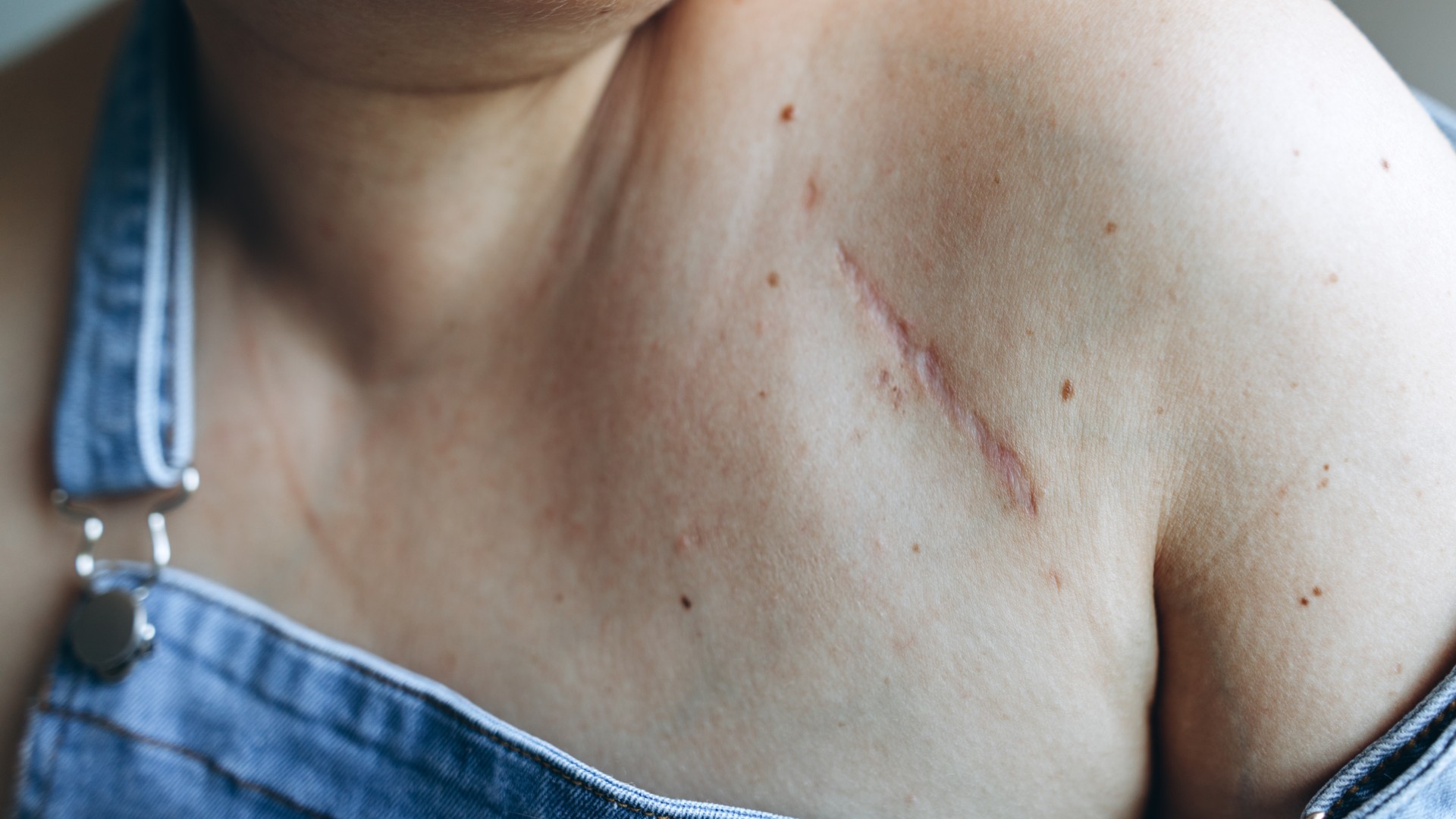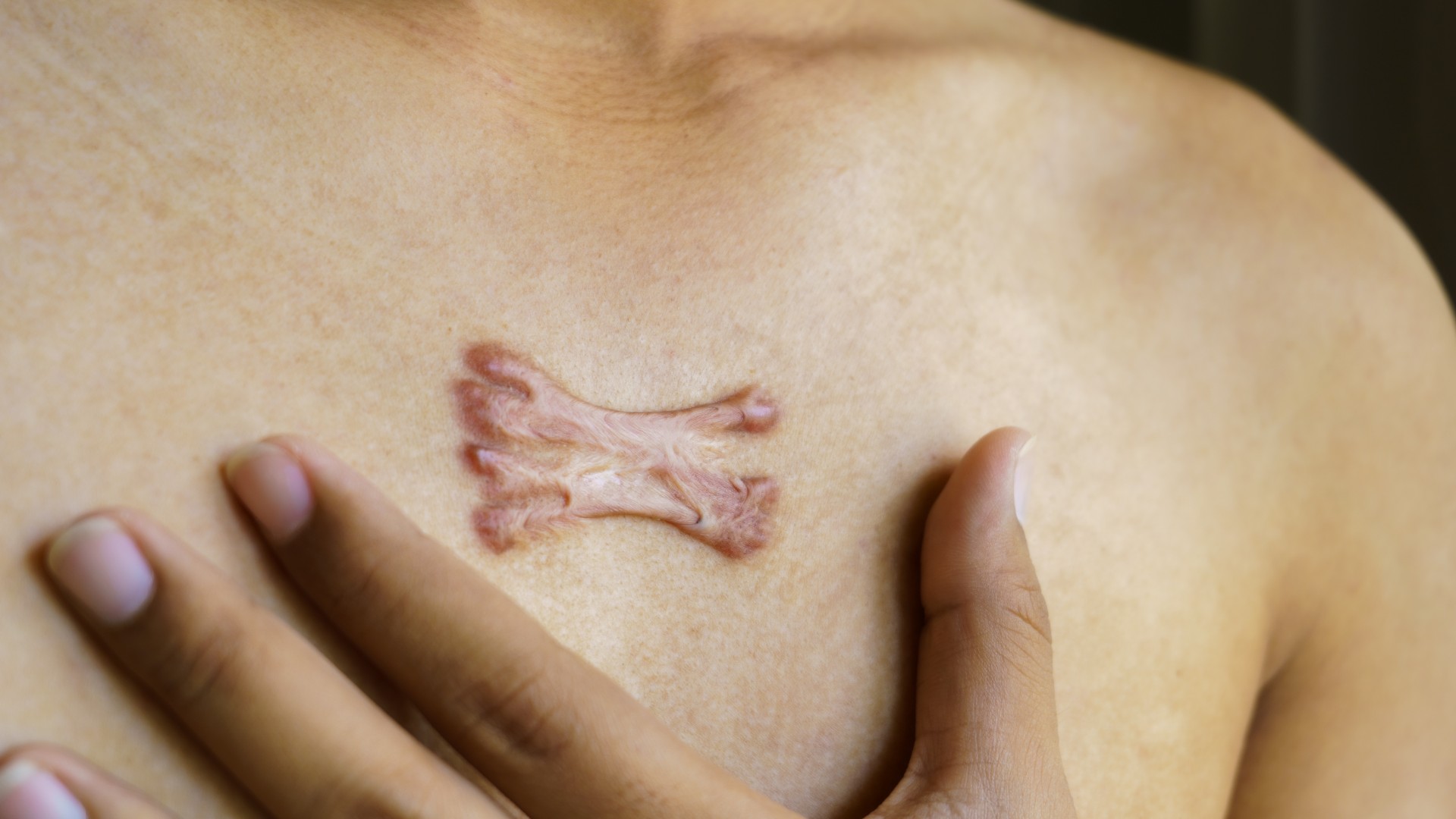
Scars come in all shapes, sizes and colors and are the result of the skin's natural healing process after damage, whether it's caused by surgery, infection, injury or rapid body growth.
Scars serve an important role: They enable the body to replace lost or disfigured tissue. But what are scars made of? And why are they permanent?
To answer these questions, first it's necessary to clarify what a scar is.
The skin is made of three main layers. The outermost layer of skin, known as the epidermis, is the thinnest layer. It's composed of layers of flattened cells, called epithelial cells, which collectively act as armor, protecting the body from the outside world.
Underneath the epidermis is the dermis, the thickest layer of skin that contains nerves, blood vessels, hair follicles and sweat and oil glands. Within the dermis, there is also a large, fibrous network of proteins called collagen and elastin that, respectively, support the structure and elasticity of the skin. Finally, the hypodermis is the deepest layer of the skin. It contains fatty tissue for insulating the body, cushioning internal organs and shielding tissues from injury.
If you damage only the epidermis — such as in most cases of sunburn — this outer layer of skin will just peel off, leaving the deeper layers of skin intact. But if an injury penetrates deep into the dermis, the body then has to repair this damaged tissue. A scab forms to seal the wound, and then inflammation initiates healing. Then, the skin begins to remodel the tissue within that wound, and the haphazard way it does this is what causes a scar to form.
In normal skin, the dermis's network of collagen fibers is like a piece of fabric that is carefully woven in a nice, smooth pattern, Dr. Damon Cooney, an associate professor of plastic and reconstructive surgery at Johns Hopkins Medicine, told Live Science. If an injury tears this fabric, the body makes new collagen fibers to fill in any gaps.
However, instead of nicely weaving the new fibers back together across the wound, the body dumps them all together in a jumbled pile, Cooney said. This disorganized buildup of collagen makes up most scar tissue, making it look different from — and move less flexibly than — normal skin.
Scar tissue also differs from unscarred skin in that it doesn't contain any hair follicles or sweat glands. In people with lighter skin, a scar may first appear pink or red, but over time, this color will fade and the scar will become slightly lighter or darker than their normal skin color. The scars of people with darker skin will often look like dark spots.
Sometimes, the body continues to lay down collagen within scar tissue for longer than it normally would, causing what's known as a keloid or a hypertrophic scar to form. These are thick, raised scars that can be red, pink or purple, or just subtly darker than a person's normal skin tone. Keloid scars are larger than the original wound, while hypertrophic scars are the same size.
Adolescents and pregnant women are more likely to develop hypertrophic scars than other groups, possibly because of hormonal changes that boost inflammation in the body. Keloid scars are more common in people with darker skin tones, likely due to genetic risk factors.
Related: Why do wrinkles form?

Scars can fade over time as the jumbled collagen fibers within them begin to flatten and smooth out, Cooney said. This process can take around six to 18 months. How much a scar fades depends on its size, location and type. However, scars never fully disappear, because the jumbled tissue remains fundamentally different from the skin around it.
In theory, there could be a way to trigger scar-free healing in humans. Some animals, like salamanders, can completely regenerate wounded skin, leaving no scars behind. Humans can also do this, but only as fetuses, during the first two trimesters of pregnancy. Beyond that point, we lose the ability to regenerate wound tissue, and scientists don't really know why.
Animal studies have shown that skin transplanted from an adult to a fetus will still scar. This suggests adult skin cells are programmed in a way that causes them to scar, rather than regenerate, after injury. Differences in the number and location of stem cells within skin may also explain why only fetal wounds regenerate. However, this research is still in its infancy.
The "pie in the sky" goal would be to develop a therapy that allows the body to switch from scarring to regeneration, Cooney said.
In the meantime, some treatments can reduce the appearance of scars. For instance, laser therapy can change the color and height of a scar, while massaging a scar, especially with silicone gel sheets, can help smooth and flatten it, Cooney said.
Other treatment options include scar revision, whereby doctors surgically remove a scar and create a new one that is more uniform in appearance. Steroid injections can also reduce the size of hypertrophic and keloid scars. These injections help disband the collagen fibers in these scars and reduce the inflammation that can cause the tissue within it to swell.
Ever wonder why some people build muscle more easily than others or why freckles come out in the sun? Send us your questions about how the human body works to community@livescience.com with the subject line "Health Desk Q," and you may see your question answered on the website!







